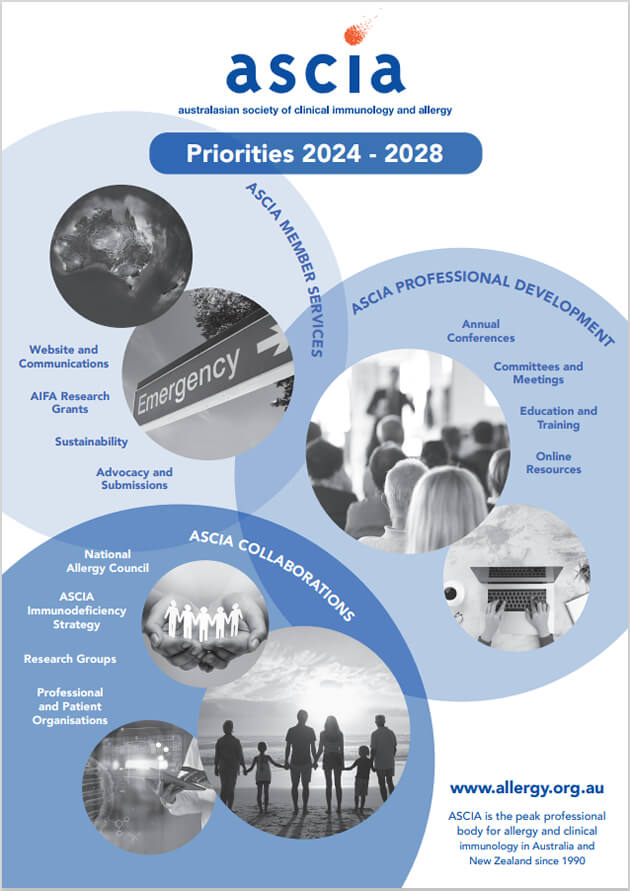Allergy Glossary of Terms
This document has been developed by ASCIA, the peak professional body of clinical immunology/allergy specialists in Australia and New Zealand. ASCIA information is based on published literature and expert review, is not influenced by commercial organisations and is not intended to replace medical advice.
For patient or carer support contact Allergy & Anaphylaxis Australia or Allergy New Zealand.
![]() ASCIA PC Glossary of Allergy Terms 2024142.89 KB
ASCIA PC Glossary of Allergy Terms 2024142.89 KB
Adrenaline (Epinephrine)
Adrenaline is a natural hormone released in response to stress. When injected, adrenaline rapidly reverses the effects of a severe allergic reaction (anaphylaxis) by reducing throat swelling, opening the airways, and maintaining heart function and blood pressure.
Allergen
A substance which can cause an allergic reaction.
Allergen immunotherapy
A series of injections or sublingual (under the tongue) tablets, sprays or drops are administered which contain the allergen such as bee venom, pollen, dust mite or animal dander to which the patient is allergic. At first the amount given is a low dose, then the amount is increased at regular intervals, over a period of three to five years. Allergen immunotherapy alters the way in which the immune system reacts to allergens, by ‘switching off’ allergy.
Allergic crease
A crease or pale line that develops across the lower part of the nose because of frequent upward wiping of the nose.
Allergic reaction
An adverse reaction involving the immune system, which is caused by inhaling, swallowing or touching a substance to which a person is allergic. It can also follow injections of medicines, insect stings or insect bites. Allergic reactions can be mild to moderate or severe (anaphylaxis). Whilst touching an allergen can cause mild-moderate symptoms, it rarely triggers anaphylaxis.
Allergic rhinitis
Commonly known as hay fever, allergic rhinitis is an inflammation of the lining of the nose caused by inhaling an allergen such as dust mite, pollens, or animal dander and by eating certain foods. Symptoms may include itching, sneezing, blocked nose, runny nose, and itchy/watery eyes.
- Perennial allergic rhinitis is when allergic symptoms occur throughout the year, usually caused by allergens such as dust mite, animal dander and mould.
- Seasonal allergic rhinitis is when allergic symptoms occur during a particular season, usually spring.
Allergic salute
When the itchy, runny, or blocked nose is being wiped in an upwards direction. This movement helps to open the nasal airways.
Allergic shiners
Dark rings under the eyes caused by allergy. Bags under the eyes can also be caused by swelling of the tissues, thus reducing circulation and drainage.
Allergy
An immune system response to a foreign substance that is harmless to most people.
Anaphylaxis
The most severe type of allergic reaction and should always be treated as a medical emergency. Anaphylaxis requires immediate treatment with adrenaline (epinephrine), which is injected into the outer mid-thigh muscle. If treatment with adrenaline is delayed, this can result in fatal anaphylaxis.
Anaphylaxis can involve many organs of the body such as the:
- Upper airways, with swelling of the throat leading to difficulty breathing.
- Nose with sneezing, blocking, watering, runny nose.
- Lungs with wheezing and asthma.
- Cardiovascular system, with a fall in blood pressure and collapse.
- Skin with welts and hives (urticaria).
Angioedema
A swelling of the deeper layers of the skin, usually in soft tissues such as the eyes, lips, tongue, and groin area.
Antibodies
Substances produced by the body to protect itself against infection. Immunoglobulin E (IgE) antibodies are produced by the body in an allergic reaction.
Antihistamines
Medications which block the action of histamine. Non-sedating antihistamines relieve allergy symptoms and are readily available from pharmacies.
Asthma
An allergic inflammation of the airways producing swelling, narrowing and the build up of mucus within the airway, leading to difficulty breathing.
Atopic dermatitis (eczema)
An inflammation of the skin which is reddened, swollen, itchy and often weeping. Atopic dermatitis is commonly known as eczema.
Beta blockers
Medications commonly used in the treatment of high blood pressure, heartbeat irregularities, migraine, overactive thyroid and glaucoma.
Bronchodilator
Medication which relaxes airway muscles and widens the air passages.
Bronchitis
An inflammation of the bronchi (large airway passages) caused by infection.
Bronchospasm/wheezing
A high pitched musical breathing sound that occurs when breathing out (most common) or breathing in. This may be due to several causes, most commonly asthma. It cannot always be heard without a stethoscope.
Cilia
Small hair-like structures that line the airways and help remove the thin film of mucus which has trapped unwanted particles.
Colic
Spasm of the colon (large intestine).
Contact dermatitis
An inflammation of the skin (blistered red, itchy, and often weeping), which is usually caused by contact with chemicals found in cosmetics, perfume, jewellery and clothing, and some plants.
Dander
Material that is shed from the body of humans and animals that have fur, hair, or feathers.
Desensitisation
Usually referred to as allergy shots or allergen immunotherapy (see allergen immunotherapy). Sublingual (under the tongue) immunotherapy is also available for some allergens.
Dust mite
A small mite invisible to the naked eye. Dust mites are widely distributed in homes and dust mite allergy is a major cause of asthma and allergic rhinitis (hay fever).
Eczema
An inflammation of the skin causing reddening, itching, swelling, and weeping (also known as atopic dermatitis).
Eosinophils
Cells that circulate in the blood. They attack tissues at the site of an allergic reaction causing damage.
Food intolerance
An adverse reaction which does not involve the immune system to ingested foods or chemicals.
Food allergy
An adverse reaction to foods such as peanuts, tree nuts, fish, shellfish, egg, soy, wheat, sesame, and cow’s milk that involves the immune system.
Food sensitivity
Another term for food allergy.
Glands
Structures which release hormones into the body, for example the thyroid or adrenal gland. The name is also loosely and incorrectly applied to lymph nodes which are part of the body's defence system.
Hay fever (see allergic rhinitis)
Histamine
A substance occurring in mast cells in the body. In an allergic reaction, it is one of the substances released which causes symptoms such as itching, sneezing, wheezing and runny nose and eyes.
Hives (see urticaria)
Immune system
The immune system is a complex network of cells and proteins that defend the body against infection. Clinical immunology/allergy specialists identify and treat the diseases that result from abnormalities of the immune system.
- Underactivity of the immune system, also called immunodeficiency, which predisposes people to infection.
- Overactivity of the immune system can take many forms, including allergic diseases(where the immune system makes an excessive response to things in the environment such as pollen or dust mite) and autoimmune diseases, where the immune system mounts a response against normal components of the body.
Immunotherapy (see allergen immunotherapy)
Immunoglobulin (see antibodies)
Inflammation
Is a defence reaction of tissues against invasion by foreign substances, which results in redness and swelling. In asthma, the inflammation is not defensive but destroys the tissues.
Latex
Latex or natural rubber is the substance obtained from the sap of the Hevea brasiliensis tree in Asia.
Mast cells
Specialised cells that lie just beneath the surface of the skin and mucosal surfaces (airways, gut, and eyes). They contain histamine and other substances which cause allergy symptoms.
Middle ear
The space between the ear drum and the inner ear. Infection in the middle ear causes acute pain and hearing loss (also known as otitis media).
Mould or fungus
Found everywhere in the environment especially associated with rotting vegetable matter. Many fungi multiply by releasing millions of spores into the air and as a result they may cause allergy/allergic symptoms if inhaled.
Mucus
A clear film of sticky liquid on the surface of the lining of the nose and lungs.
Non-steroidal anti-inflammatory drugs (NSAIDs)
Medications which reduce pain and inflammation. Often in analgesics and anti-inflammatory medications. Can also be found in cold and flu medications. A problem for most patients with aspirin allergy.
Occupational allergens
Allergens encountered during a person's work. Examples are western red cedar which may cause asthma in saw millers and carpenters; animal dander in veterinarians and laboratory workers; latex in health care professionals.
Oesophageal reflux
A condition where muscles at the lower end of the oesophagus (the tube which leads from the mouth to the stomach), does not function properly and allows acid stomach contents to move upwards back into the oesophagus, causing a painful burning sensation because of gastric (stomach) acids.
Oral allergy syndrome (pollen allergy syndrome)
People with Oral Allergy Syndrome, also known as Pollen Food Syndrome, are sensitive to substances in pollen and similar substances present in other plants, like raw or semi-cooked fruit or vegetables. This is known as cross-reactivity. In this condition, itching and swelling of the mouth and tongue occurs, usually after eating uncooked or semi-cooked fruit.
Otitis media
Infection of the middle ear.
Pollen
The pollen grain is a tiny particle carried by insects or wind to fertilise the female flower. Breathing in pollen causes allergic rhinitis (hay fever) and asthma in some people.
Sinusitis
Inflammation of the sinuses (air cavities connected to the nasal passages). If the lining of the sinuses becomes inflamed and infected, the condition is called sinusitis.
Skin prick test
A skin test to identify reactions to allergens. A positive test is one where a raised itchy lump (wheal) surrounded by a flat red area (flare) develops within 15-20 minutes.
Specific IgE blood allergy test (formally known as RAST)
A blood test for allergen specific Immunoglobulin E (IgE) antibodies which identifies reactions to specific allergens such as dust mite, pollen, animal dander, moulds, foods, and some insect venoms.
Steroids
A shortened word for corticosteroids (and not to be confused with body building steroids). They are a group of medications used to prevent or suppress the symptoms of severe inflammation due to any cause and prevent the tissue damage that may otherwise result.
Symptom diary
A daily record of a person’s symptoms.
Urticaria (hives)
The medical word for hives, which are itchy, raised lumps that can vary in position from hour to hour or day to day.
Wheal
A raised whitish itchy lump, which occurs after skin prick test or after contact with an allergen and is a term also used to describe the individual lump seen in hives.
© ASCIA 2024
Content updated March 2024
For more information go to www.allergy.org.au/patients/about-allergy
To support allergy and immunology research go to www.allergyimmunology.org.au/donate


 Allergic reactions occur when a person reacts to substances in the environment that are harmless to most people. These substances are known as allergens, and are most commonly found in dust mites, pets, pollen, insects, ticks, moulds, foods, latex and some drugs (medications).
Allergic reactions occur when a person reacts to substances in the environment that are harmless to most people. These substances are known as allergens, and are most commonly found in dust mites, pets, pollen, insects, ticks, moulds, foods, latex and some drugs (medications).